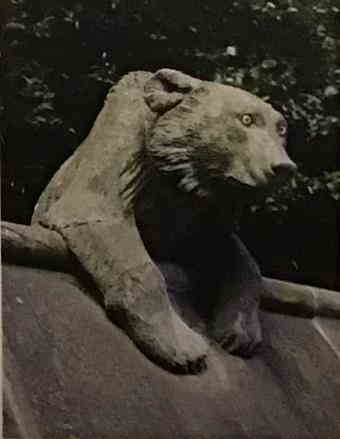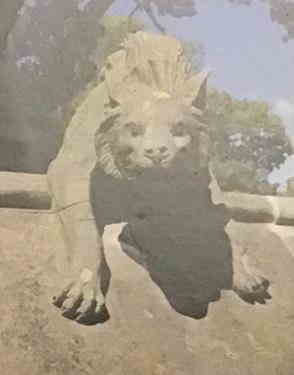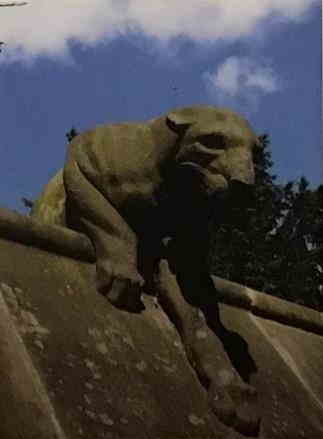
No.586 January 2020 Edited by Peter Pickering
HADAS DIARY – LECTURE PROGRAMME 2020
Except for the January one, which is in the afternoon, lectures start at 7.45 for 8.00pm. They are in the Drawing Room, Avenue House, 17 East End Road, Finchley N3 3QE. Buses 82, 143, 326 & 460 pass close by, and it is five to ten minutes walk from Finchley Central Station (Northern Line). Tea/coffee and biscuits follow the talk.
Tuesday 14th January 2020 at 2.30pm
Ian Jones
Shelters to Shrapnel, surviving traces of Enfield At War, 1939-1945
A look at the World War II monuments in Enfield including those that survive, those that have been demolished since earlier recording in the 70s and 80s, sites excavated and some of the finds made.
Ian Jones began as a schoolteacher, and later joined Harlow Museum ending as curator. Since leaving, has become a part-time adult education lecturer, local historian and author and is currently Chairman of the Enfield Archaeological Society, which he originally joined in 1958.
Tuesday 11th February 2020. The Dorothy Newbury Memorial Lecture
Jon Cotton
Prehistory in London – some Problems, Progress and Potential
Tuesday 10th March 2020
Lyn Blackmore From Crosse and Blackwell to Crossrail – MOLA excavations at Tottenham Court Road 2009–10
Tuesday 14th April 2020
Signe Hoffos
Lost City Churches
Tuesday 12th May 2020
Tim Williams
Archaeology of the Silk Roads
Tuesday 9th June 2020
ANNUAL GENERAL MEETING
From the Chairman
I will be retiring as chairman of HADAS, after 16 enjoyable years, at the next AGM in June 2020. Tempus fugit and at 83 years old it is time for someone perhaps younger to take the reins. I am making this announcement now, to give reasonable notice to plan my replacement.
The role of HADAS chairman includes chairing four committee meetings during the year, writing an annual report for the AGM on the year’s activities, assisting the secretary to produce agendas, head the committee in making decisions for the benefit of the society and its members.
ANDERSONS AND ACK ACK: the 20th Century Conflict Archaeology of London –
The October Lecture by Andy Brockman Deirdre Barrie
The First World War is now scarcely within living memory, and even witnesses of the Second World War are fast diminishing. For instance, there now remain only four Battle of Britain air crew out of an original total of 300. Thus (says Andy Brockman) the archaeology of this modern conflict is one of the newest and fastest-moving disciplines in archaeology.
Andy began with the first ever blitzkrieg by the Germans during the First World War in 1915-1916. A slide of a German propaganda poster showed matchstick people scattering in terror from an aerial attack on Trafalgar Square.
The earliest anti-aircraft battery was built in 1913, but by 1915 there was serious zeppelin damage. One infamous incident in 1917 was the bombing of Upper Norwood School in Poplar, where 18 children aged 4-6 and their teacher were killed.
Enemy airships were based in Southern Germany, and once over here they navigated by following railway lines. German airships would send back weather reports in Morse code to bases in Southern Germany, which by triangulation allowed us to locate the bases.
Another slide showed an idealised view of a German airship, with the commander on a speaking tube to the engine room. Because of the high altitude, airship crew needed to be dressed like sailors in winter. There were no parachutes; thus dark conversations took place at German crew bases as to whether it was better when your airship caught light to jump, or to go down in flames.
Zeppelins flew so high that crew often passed out, though later they used liquid oxygen to help them breathe. The zeppelins were driven by marine diesel engines, whose fumes caused the crew nausea and migraines. This was one of the most dangerous ways to go to war, especially for one unprotected wretch, the lonely machine-gunner high on the prow of the ship. When German airships crashed, the British copied their designs. By the beginning of 1916, Kapitanleutnant Heinrich Mathy of the Navy Airship Division in Germany confessed that things were in a bad way. He himself was killed at the site of the L3 crash at Potters Bar by jumping from the airship.
During the Second World War, there was a ring of defences all round London to deter the invaders. In his talk Andy commented mostly on Shooters Hill, which happens to be on the main road to London from Kent and the coast, and a height of tactical importance. Even if the enemy had got past some of the defences, the navy could have steamed up the channel, cut off their supply lines and left them stranded.
The area is still littered with the remains of defences. A former farm at Shooters Hill was a prisoner-of-war camp within living memory. The concrete and iron anchoring points for barrage balloons are still
discoverable in Eaglesfield Park. On the hill itself were “pill boxes”, anti-tank devices and at least one fiery booby trap, an anti-tank device called a flame fougasse.
A Shooters Hill local, Peter James, described how in the 1930s/1940s he was told that a big metal circle at the top of Shooters Hill was the site of an anti-aircraft gun.
Andy commented that it was advisable always to take two geophysics readings of an area and compare them. The first geophysics reading of this anti-aircraft gun site showed two First World War anti-aircraft guns – well built, with the bases immaculately level. But at some time in the Second World War a different weapon had been on the same site – not such a careful job. Metal detecting revealed conduits leading back to Whitehall or Woolwich. A cut-out French coin was also found – perhaps a keepsake from France?
RAF photos are invaluable for research. They show building losses, anti-aircraft gun sites and field boundaries, (as well as lots of much earlier archaeology!)
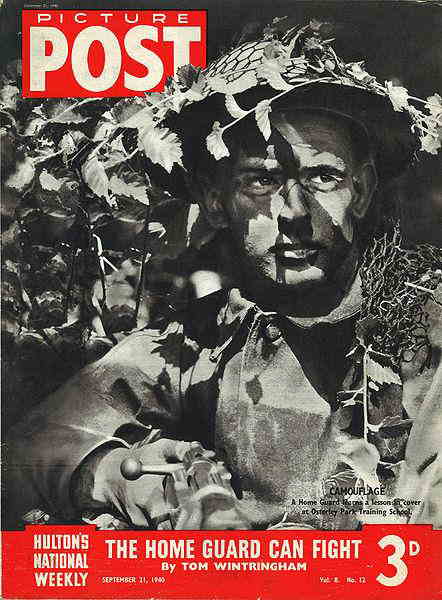
As early as 1938, Tom Wintringham, (soldier, military historian and politician) was campaigning for home defence units, which would eventually become the Home Guard. We are now used now to the “Dad’s Army” and Compton Mackenzie’s view of the Home Guard as bumbling and incompetent. But with Wintringham’s influence, “Picture Post” published an edition with a photo on the cover of a very heroic-looking member of the Home Guard.
The Home Guard were trained at the neo-classical Osterley Park, an Adam house now run by the National Trust. “Do what you want, but don’t damage the house!” the Home Guard were told. To join the Home Guard, volunteers over 41 would sign up at a local police station. However, for various reasons, some would soon resign.
Only now are we beginning to realise the importance of these wartime sites, which are disregarded all around us and need to be investigated and recorded before it is too late. Andy stressed that local archaeological groups and heritage projects now have a significant role to play in discovering and understanding the conflict archaeology of their communities.
Here are the links. The Time Team Shooters Hill episode: Time Team S15-EO8 Blitzkreig on Shooters Hill, London https://www.youtube.com/watch?v=Z4J-iIrtVoc .The Potters Bar Zeppelin: http://www.hellfirecorner.co.uk/pottersbar/pottersbar.htm
NEXT STOP SEATON! 66 years of Modern Electric Tramways Limited By David Voice Published by Adam Gordon 2019 ISBN 978-1-910654-23-1 Price £25.00, soft back. Reviewed by Andy Simpson
The publication this autumn of the new and expanded fourth edition of the book reviewed below is an opportunity to revisit and expand the review of the second revised and enlarged edition originally published in the HADAS newsletter of October 2003.
Why review a book about a three-mile long narrow-gauge tourist tramway running along a river estuary in Devon (and visited by HADAS on a long weekend in September 2006)? Well, read on. This book is full of Barnet, Hadley and Hendon connections. The 2003 edition celebrated the golden jubilee in 2003 of the Modern Electric Tramways Company, formed 19th May 1953 by Claude Lane to run his trams; and the Seaton Tramway founded by him happily thrives to this day.
Claude Lane was born in 1908 in Totteridge, the son of William Lane, joint manager of Manor Farm Dairies, Highgate; having introduced pasteurisation he became a director. In 1911 the family moved to Finchley, where the infant Claude, fascinated by trams, would persuade his nanny to take him to the tram depot off Rosemont Avenue to watch them entering and leaving the depot. As a young boy he would travel to Hendon to watch the trams at the depot/workshops on the Edgware Road, where the now rebuilt Merit House later stood – of which more later. At school he developed a flair for electricity and mechanics and served his electrical engineering apprenticeship at Stoke Newington power station. Aged 22, he formed the Barnet based ‘Mobile Welding and Workshop Company’, and opened a small workshop in Lancaster Road, New Barnet, renamed the Lancaster Electrical Company, after the road. Here he repaired batteries, radios and the like.
A growing interest in battery vehicles led to his building a workshop at 77-79 Brookhill Road, New Barnet, whilst spending his summer holidays driving trams in Llandudno and Blackpool. From the Second World War his company produced many battery-operated vehicles such as the ‘Lecar’ for local deliveries by traders. In early 1949, he produced his first own 15-inch gauge scale model tram, number 23, based on a modern double decker then running in Llandudno; he built a test track in the Barnet works and locals soon got used to this little tram peeping out of the Brookhill Road entrance and running around the yard, through the sawmill, and around the open area at the rear of the works, giving rides to local children. As news spread, invitations to local fetes, using portable overhead and track, grew; one such being the Hadley House Conservative Association Fete on 2nd July 1949, followed by South Mimms on 23rd July, when the tram was filmed by British Movietone News. Summer weekends saw the tram travel as far as Hitchin and Uxbridge, often with ‘19 Barnet’ on its destination blinds – the pre-1938 route via Finchley to High Barnet. In 1950 a second tram was completed in New Barnet, based on the ‘Blackpool Boat’ open top single deck design, and numbered 225. In 1951 the two trams moved to a new sea-front miniature tramway at St Leonards, Hastings, as a holiday attraction. They were supplemented in 1952 by a third Barnet-built tramcar, a traditional four-wheel open topper, number 3, but local complaints had seen an end to the Hastings operation after a few months. Also built at Barnet in 1952 was a four-wheeled battery-operated tram for the Air Ministry, which in rebuilt form remains at Seaton as a works car. In 1952 the whole set-up moved to a park at Rhyl. A planned move to Eastbourne in East Sussex saw trams 225 and 3 move back to Barnet for refurbishment. The Rhyl operation was leased out and the Barnet works produced a fourth tram, open ‘toastrack’ number 6, in 1954 to help maintain services there. The Rhyl operation closed in 1957.
Operations in Princes Park, Eastbourne began in 1954, with the track gauge increased to two feet. Barnet works produced a second ‘boat’ car, No.226 to help work the line that year. In 1960 the chassis was modified as a works car and later served as a mobile shop and even as a café and ticket office; it is currently stored out of use at Seaton. Car number 238, based on the double-deck Blackpool ‘Balloon’ design was built at Barnet in 1955. Toastrack number 6 was rebuilt at Barnet 1955/56 as a traditional bogie open top car using parts from original full-sized trams – controllers from Southampton and top deck seats, wire mesh, headlights, gongs, bells and circuit breakers rescued from the scrapman at Llandudno which lost its street tramway in March 1956, and remains in service at Seaton. The last tram partially built in East Barnet, in 1958, was similar tram number 7, again using full-sized components such as more electrical gear rescued from recently scrapped Llandudno trams, and seats from Leeds trams; it also remains in service at Seaton.
The Barnet works closed shortly afterwards, and were sold in 1959; now demolished, a field visit kindly undertaken by Bill Bass in November 2019 showed that the site is now covered by a large modern three-story block of flats, ‘Ludlow Court’- see photos by Bill below.
Tramway operations moved entirely to Eastbourne, where the tramway was partly lit by ex-Hendon UDC gas lamps! Also built at Barnet in 1957 was a miniature Edwardian L.G.O.C- ‘B’ type open top bus, based on the 1929 chassis of a Swift car, registration LA 9927, which is currently undergoing restoration. In 1963, three of the Barnet built trams – 3, 225, and 238 – were sold to a collector in America and shipped out in November; sadly, their current location is not known. Barnet built Cars 6 and 7 remain in operation at Seaton, where the tramway moved to in 1969. In October 1964 the former Metropolitan Electric Tramways tram/trolleybus depot and works in Hendon, where Merit House now stands opposite the oriental shopping complex, was being demolished, following closure in 1962, and Claude Lane rescued two sets of depot gates, for use at Eastbourne and, later, Seaton. Another local link at Seaton is tram 14, originally Metropolitan Electric Tramways 94 of 1904, later London Transport 2455, rescued in 1961 from an orchard near Waltham Cross, and now cut down to single deck, of the type once common around Hendon, Finchley and Barnet until the local tramways converted to trolleybus operation c.1935-1938.
This is a splendid book. Though not cheap, it is well written with plenty of ‘human interest’ and lots of pictures of the Barnet works and its advertising literature, Hadley Fete, and the Hendon depot gates! Well recommended for transport and local history enthusiasts.
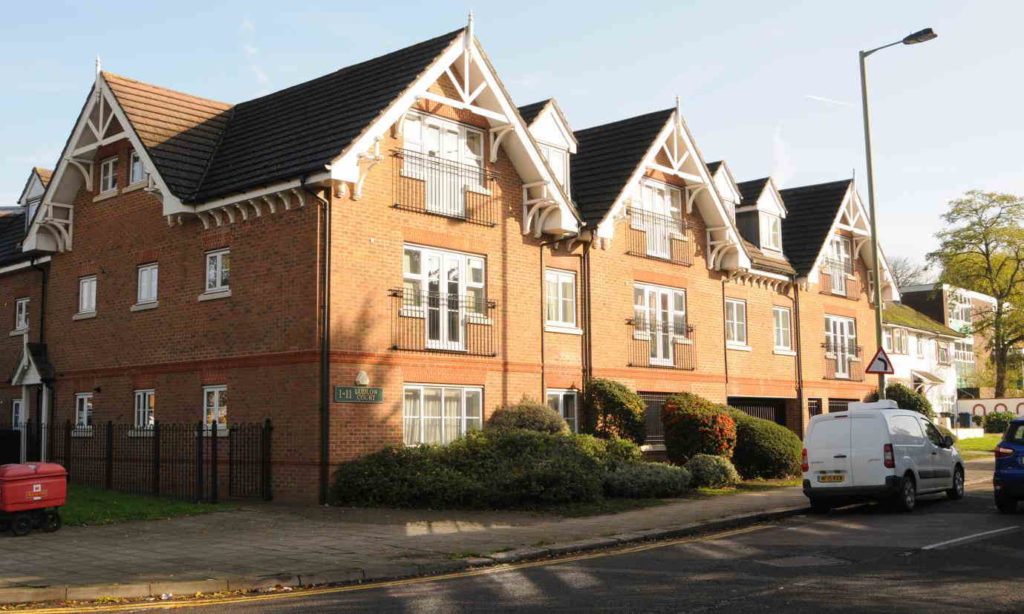
HADAS TRIP Day 2 (continued) Jim Nelhams
Leaving Llandaff, our coach took us into the centre of Cardiff, dropping everybody by the walls of Cardiff Castle. The castle has lots of steps, particularly in the keep, so some opted to visit the museum and art gallery or local shops.
CARDIFF CASTLE Dudley Miles
The first building on the site was a Roman fort, built to subdue the warlike tribe of the Silures, which controlled south-east Wales. A stretch of Roman wall survives in the basement of the visitor centre. William the Conqueror invaded south-east Wales and in 1081 he built a motte-and-bailey castle with a wooden keep on the site. Around 1135, this was replaced by a stone keep, considered the finest in Wales, by Robert of Gloucester, probably in response to a Welsh rising.
In the fifteenth century the castle began its transformation into a comfortable residence with the construction of a mansion built into the western wall of the bailey. Three hundred years later, the mansion was refurbished and extended, while Capability Brown’s vision of a fashionable landscape led him to demolish many important ancient buildings and the wall which divided the inner and outer bailey. In the late nineteenth century, the 3rd Marquess of Bute, then the richest man in Britain, employed the architect William Burges to transform the mansion into an outstanding example of Gothic Revival architecture. Some rooms in the mansion are open to the public and others can be seen on a fascinating guided tour.
THE ANIMAL WALL AT BUTE PARK Audrey Hooson
On our visit to Cardiff Castle I was keen to see the highly decorated rooms in the Victorian Gothic castle apartments. These were designed by architect William Burges for the 3rd Marquis of Bute, with the project started in 1866 and continued by the 4th Marquis. The rooms are famous for the amount of decoration they contain with many animals, plants etc. and depict historical and mythical stories.
We did not have to wait very long for our first sight. As we stepped from the coach, we saw the Grade 1 listed Animal Wall at Bute Park. This was planned by Burges and built in 1890, after his death; it was originally located in front of the castle. Road widening as the Centre of Cardiff became busier necessitated re-positioning to the west around Bute Park. For people who are used to animals in heraldic representation or relief panels inserted into walls they are quite a surprise. They all look as if they are looking over the wall from Bute Park and possibly trying to escape. The first nine designed by Thomas Nicholls in 1890 have glass eyes and were originally painted. In 1931, six further animals were sculpted by Alexander Carrick.
During the 1930s the animals featured in a children’s cartoon in the South Wales Echo; they are still a very popular sight in the centre of Cardiff.
Cardiff Museum of Natural History & National Museum of Art
A short distance away from the castle stand a number of civic buildings dating from 1906 and including the City Hall. Next to this stands the museum building, at the time of our visit undergoing roof repairs. Like many city centre museums, it has run out of space, so historic and archaeological exhibits have been transferred in recent years to new buildings at St Fagans, which we would visit later in the trip.
On the ground floor is the natural history section – imaginatively displayed – covering the geological and historical development of Wales and including a woolly mammoth which moves and trumpets.
Much of the first floor is devoted to art, including the work of a number of Welsh painters, but also a display of Welsh ceramics.
Llandaff postscript Jim Nelhams
While returning from Llandaff Cathedral to our coach, we found a small excavation underway near the Bishop’s Castle at the top of the hill. The following is reprinted by kind permission of ‘Wales Online’. “A Medieval dwelling dating back to the 1400s has been discovered under a derelict toilet block in Cardiff . “An excavation of the site in Llandaff in September revealed the building, which expert archaeologists believe was home to someone important. “It is quite a high-status building, it includes a Bath Stone fire surround which was imported from the Bath area and it is not really known as a stone in Llandaff,” said Dr Tim Young, the archaeologist leading the dig. The ground floor of the house remains fully intact, and it is believed the first floor was demolished in the 17th century when the land was then used for an animal pound.
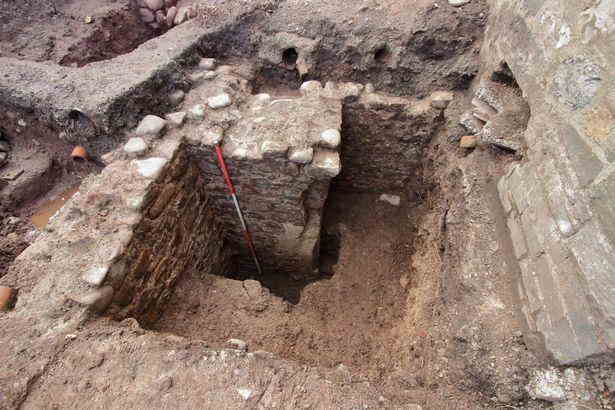
Among the finds were animal bones, pots, and a counting token called a Jetton, which is believed to have been struck in Paris in the 1300s.

There are a number of theories behind who may have lived in the dwelling next to the 13th Century Old Bishop’s Castle; one includes a housekeeper for the nearby Manor of Llandaff or an official of the Llandaff Cathedral “The site is known as the pound as it was the animal pound for Llandaff and we have evidence of that dating back to about 1607. It had always been assumed that the area was also the pound before that so the discovery of a medieval dwelling on the site was quite unexpected,” said Dr Young, who is a teaching associate at Cardiff University. Finds from the dig will now be sent to experts at Cardiff University and other national museums in order to learn more about the site. “It won’t be for another six months or even a year until we could come to any sort of conclusion,” said Dr Young. Dr Young added they were very surprised by the find as there was no evidence from any of the surviving maps from that time to suggest there had been a building there. The dig was part of a community project set up by Llandaff 50+ as part of a transfer of community assets by the council to the club, who intend to turn the disused toilets into a new community venue. The club was granted funding from the National Heritage Lottery Fund and Cardiff YMCA Trust to run the community project and refurbish the toilets. More than 250 children from nearby schools helped with the dig which ran from September 16 to 27. A local storyteller was able to bring history alive for the children, which helped make the community dig a real success, said Yvonne Apsitis, chairwoman of the Llandaff 50+ club. “We have never really done much with children in the community before so this seemed the perfect opportunity. We had people as old as 80 work at the dig. It was a really enjoyable experience,” said the 79-year-old. The site will now be filled back in as work continues on restoring the area.
Two new books of interest 1. How Hampstead Heath was saved. Review by Andrew Bosi, (first published in News Forum, the newsletter of the London Forum)
Helen Lawrence’s new book has been published (by the Camden History Society, £14.95, order online through the Camden History Society website) to coincide with the latest twist in the history of the Heath – the return of sheep grazing. She charts in great detail the long struggle over ownership of the Heath and the rights and easements granted or withheld. There is a critique of earlier publications and this book brings together the full story to date, acknowledging that it will continue to evolve and urging vigilance on readers who might be faced with challenges in the future.
Hampstead has always been inhabited by more than its share of the great and the good and it is interesting to speculate, as you read the book, how Epping Forest might have fared if it had fallen into the same ownership. The book is sub-titled a Story of People Power and although legislation has changed out of all recognition there are echoes of the petitioning of Parliament over the Channel Tunnel Rail Link in the account of how successive Bills in Parliament designed to permit unwanted development were rebuffed.
Surprisingly, the coming of the Railways did not pose a threat to the heath and the Hampstead Junction railway skirting the southern edge of the heath strengthened the argument that this is a London wide resource. None of the radial routes to the north come anywhere near.
Changes to local government on the other hand posed more difficulties. Within the living memory of most readers, the abolition of the Greater London Council and the long drawn out debate about how its functions were to be administered involved twists and turns that are faithfully recorded here.
In places the left justification of the text results in some confusing spacing: one or two errors have escaped the proof readers. The book is copiously illustrated and very reasonably priced. A rather limited print run may mean first editions become a much sought after investment in years to come. Anyone with an interest in the history of the Heath, or needing to fight for open space elsewhere, will want to make that investment now.
Londinium: a Biography – Roman London from its origins to the Fifth Century
By Richard Hingley, Professor of Roman Archaeology at the University of Durham Bloomsbury Academic 2018 Price £17.50 paperback
‘Archaeological work’, writes Professor Hingley, has since the mid-1990s, entirely transformed the comprehension of London’s Roman past . . . particularly with regard to the characters and lives of its occupants and the later history of Londinium’. He attempts in this book a current synthesis, dividing the life of Roman London into some six periods, and looking one by one at aspects of London’s life in each period. For instance, under ‘Peak of Development from AD125 to AD200’ there are sections ‘People and status’ ‘Monumental buildings and infrastructure’ ‘Occupation’, and ‘Marking the boundaries’. Professor Hingley indicates scrupulously when the evidence for any conclusion is uncertain or ambiguous. He does not think the decline of Londinium during the third and fourth centuries was anything like as marked as we are often told.
The book will be invaluable as the basis for research or study of anything relating to Roman London – though of course everything in it must be provisional as new discoveries continue to be made. The illustrations are full, but can be murky – in a reasonably priced paperback they are in the text, not on separate plates.
OTHER SOCIETIES’ EVENTS compiled by Eric Morgan Please check with the organisations before setting out in case of any changes / cancellations. Many organisations expect a small contribution from visitors. Tuesday 14th January 6.30 pm London and Middlesex Archaeological Society Clore Learning Centre, Museum of London, 150 London Wall, EC2Y 5HN Which Bottles are ‘Witch’ Bottles? Talk by Nigel Jeffries, exploring Ralph Merrifield’s legacy in the field of early modern bottle magic in England. Refreshments from 6 o’clock
Tuesday 14th January 7.45 pm Amateur Geological Society Finchley Baptist Church Hall 6 East End Road opposite Avenue House Milankovitch Cycles and other cosmic influences on our climate Talk by Professor Alan Aylward.
Wednesday 22nd January, 7.45 pm Friern Barnet and District Local History Society. North Middlesex Golf Club, The Manor House, Friern Barnet Lane N20 0NL. All Over by Christmas: the Home Front in the First World War Talk by David Berguer
Thursday 30th January 2.30 pm. Finchley Society. Drawing Room, Avenue House Talk by Helen Fry on Trent Park in the Second World War and other buildings used for interrogation. NOTE AFTERNOON MEETING
Sunday 2nd February. 10.30 am Heath and Hampstead Society. Laughter in the Landscape; a walk to celebrate Grimaldi Sunday. Explore ‘Appy ‘Ampstead with Lester Hillmany Marc Hutchinson. Meet at the Old Bull and Bush North End Way NW3 Lasts about two hours. MUST BOOK – www.heathandhampstead.org.uk or 07941528034. Donation £5.
Thursday 6th February 8pm Pinner Local History Society Village Hall, Chapel Lane car park, Pinner HA5 1AB. Behind the scenes at the Battle of Britain. Talk by David Keen, including Bentley Priory’s place in history.
Wednesday 12th February. 2.30 pm Mill Hill Historical Society Trinity Church 100, The Broadway NW7 3TB French Horticultural Gardens and current influences. Talk by Chelle Price
Wednesday 12th February 7.45 pm Hornsey Historical Society. Union Church Hall, corner Ferme Park Road/Weston Park N8 9PX. Beating the Bounds Talk by Mark Lewis
Monday 17th February. 8.00 pm. Enfield Society Jubilee Hall, 2 Parsonage Lane/junction Chase Side, Enfield EN2 0AJ. Lost buildings of Enfield Talk by Joe Studman. (including Enfield Palace, Enfield Assembly Rooms, Zion and Chase side Chapels, Gentleman’s Row Bothy, Cecil Road Farm as well as inns and cinemas) (Wrongly entered as 10.30 am in print version)
Monday 17th February 8.15 pm Ruislip, Northwood and Eastcote Local History Society St Martin’s Church Hall High Street Ruislip HA4 8DG Excavations at Eastcote House Gardens. Talk by Les Capon (AOC Archaeology).
Wednesday 19th February. 8pm. Edmonton Hundred Historical Society. Jubilee Hall, 2 Parsonage Lane/junction Chase Side, Enfield EN2 0AJ The Bayeux Tapestry. Mike Brown.
Wednesday 19th February 7.30pm. Willesden Local History Society. St Mary’s Church Hall, Neasden Lane, NW10 2TS (nr Magistrates Court) The Willesden Green Library Story Talk by Philip Grant, celebrating the 125th anniversary – the Library opened in 1894 and has been at the heart of the local community.
Thursday 20th February 8pm Historical Association – Hampstead and NW London branch. Fellowship House, 136A Willifield Way NW6 6YD Jews in the Roman Empire Talk by Dr David Nay on their flourishing in many parts of the empire until changes under fourth century Christian emperors. (Wrongly entered as 27th February in print version)
12
Friday 21st February. 7.30 pm. Wembley History Society English Martyrs’ Hall, Chalkhill Road, Wembley, HA9 9EW (top of Blackbird Hill, adjacent to church) The Home Front during the Second World War Talk by Christine Coates.
Wednesday 26th February. 2.30 pm. Enfield Society Jubilee Hall, 2 Parsonage Lane/junction Chase Side, Enfield EN2 0AJ.Lavender Hill cemetery Talk by Joe Studman, looking at some of the graves to reveal a potted history of late Victorian and Edwardian Enfield.
Wednesday 26th February, 7.45 pm Friern Barnet and District Local History Society North Middlesex Golf Club, The Manor House, Friern Barnet Lane N20 0NL. London Film Locations Talk by Diane Burstein
Thursday 27th February 2.30 pm. Finchley Society. Drawing Room, Avenue House, West Finchley Neighbourhood Plan Talk by Kieran Kettleton. NOTE AFTERNOON MEETING
Friday 28th and Saturday 29th February. Current Archaeology Live 2020. Conference in the University of London Senate House, Malet Street WC1E 7HU. Wide range of expert speakers sharing the latest archaeological finds and research. For details and tickets visit www.archaeologylive.co.uk or ring 020 8819 5580.
With many thanks to this month’s contributors:
Bill Bass, Deidre Barrie, Don Cooper, Audrey Hooson,
Jo and Jim Nelhams, Dudley Miles, Eric Morgan and Andy Simpson.
Hendon and District Archaeological Society
Chairman Don Cooper 59, Potters Road, Barnet EN5 5HS (020 8440 4350)
e-mail: chairman@hadas.org.uk
Hon. Secretary Jo Nelhams 61 Potters Road Barnet EN5 5HS (020 8449 7076)
e-mail: secretary@hadas.org.uk
Hon. Treasurer Roger Chapman 50 Summerlee Ave, London N2 9QP (07855 304488) e-mail: treasurer@hadas.org.uk
Membership Sec. Stephen Brunning 22 Goodwin Court, 52 Church Hill Road, East Barnet EN4 8FH (0208 440 8421) e-mail: membership@hadas.org.uk




